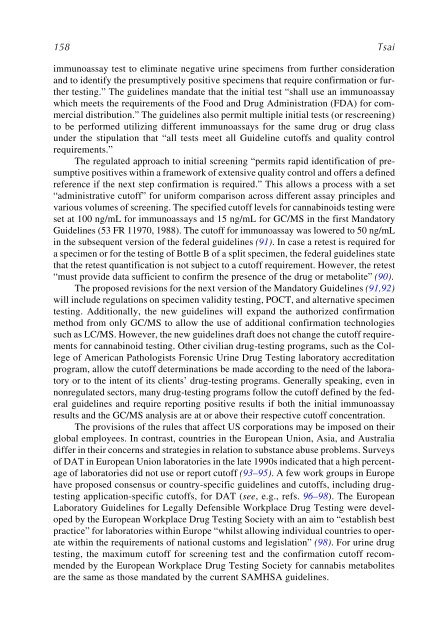Marijuana and the Cannabinoids
Marijuana and the Cannabinoids
Marijuana and the Cannabinoids
Create successful ePaper yourself
Turn your PDF publications into a flip-book with our unique Google optimized e-Paper software.
158 Tsai<br />
immunoassay test to eliminate negative urine specimens from fur<strong>the</strong>r consideration<br />
<strong>and</strong> to identify <strong>the</strong> presumptively positive specimens that require confirmation or fur<strong>the</strong>r<br />
testing.” The guidelines m<strong>and</strong>ate that <strong>the</strong> initial test “shall use an immunoassay<br />
which meets <strong>the</strong> requirements of <strong>the</strong> Food <strong>and</strong> Drug Administration (FDA) for commercial<br />
distribution.” The guidelines also permit multiple initial tests (or rescreening)<br />
to be performed utilizing different immunoassays for <strong>the</strong> same drug or drug class<br />
under <strong>the</strong> stipulation that “all tests meet all Guideline cutoffs <strong>and</strong> quality control<br />
requirements.”<br />
The regulated approach to initial screening “permits rapid identification of presumptive<br />
positives within a framework of extensive quality control <strong>and</strong> offers a defined<br />
reference if <strong>the</strong> next step confirmation is required.” This allows a process with a set<br />
“administrative cutoff” for uniform comparison across different assay principles <strong>and</strong><br />
various volumes of screening. The specified cutoff levels for cannabinoids testing were<br />
set at 100 ng/mL for immunoassays <strong>and</strong> 15 ng/mL for GC/MS in <strong>the</strong> first M<strong>and</strong>atory<br />
Guidelines (53 FR 11970, 1988). The cutoff for immunoassay was lowered to 50 ng/mL<br />
in <strong>the</strong> subsequent version of <strong>the</strong> federal guidelines (91). In case a retest is required for<br />
a specimen or for <strong>the</strong> testing of Bottle B of a split specimen, <strong>the</strong> federal guidelines state<br />
that <strong>the</strong> retest quantification is not subject to a cutoff requirement. However, <strong>the</strong> retest<br />
“must provide data sufficient to confirm <strong>the</strong> presence of <strong>the</strong> drug or metabolite” (90).<br />
The proposed revisions for <strong>the</strong> next version of <strong>the</strong> M<strong>and</strong>atory Guidelines (91,92)<br />
will include regulations on specimen validity testing, POCT, <strong>and</strong> alternative specimen<br />
testing. Additionally, <strong>the</strong> new guidelines will exp<strong>and</strong> <strong>the</strong> authorized confirmation<br />
method from only GC/MS to allow <strong>the</strong> use of additional confirmation technologies<br />
such as LC/MS. However, <strong>the</strong> new guidelines draft does not change <strong>the</strong> cutoff requirements<br />
for cannabinoid testing. O<strong>the</strong>r civilian drug-testing programs, such as <strong>the</strong> College<br />
of American Pathologists Forensic Urine Drug Testing laboratory accreditation<br />
program, allow <strong>the</strong> cutoff determinations be made according to <strong>the</strong> need of <strong>the</strong> laboratory<br />
or to <strong>the</strong> intent of its clients’ drug-testing programs. Generally speaking, even in<br />
nonregulated sectors, many drug-testing programs follow <strong>the</strong> cutoff defined by <strong>the</strong> federal<br />
guidelines <strong>and</strong> require reporting positive results if both <strong>the</strong> initial immunoassay<br />
results <strong>and</strong> <strong>the</strong> GC/MS analysis are at or above <strong>the</strong>ir respective cutoff concentration.<br />
The provisions of <strong>the</strong> rules that affect US corporations may be imposed on <strong>the</strong>ir<br />
global employees. In contrast, countries in <strong>the</strong> European Union, Asia, <strong>and</strong> Australia<br />
differ in <strong>the</strong>ir concerns <strong>and</strong> strategies in relation to substance abuse problems. Surveys<br />
of DAT in European Union laboratories in <strong>the</strong> late 1990s indicated that a high percentage<br />
of laboratories did not use or report cutoff (93–95). A few work groups in Europe<br />
have proposed consensus or country-specific guidelines <strong>and</strong> cutoffs, including drugtesting<br />
application-specific cutoffs, for DAT (see, e.g., refs. 96–98). The European<br />
Laboratory Guidelines for Legally Defensible Workplace Drug Testing were developed<br />
by <strong>the</strong> European Workplace Drug Testing Society with an aim to “establish best<br />
practice” for laboratories within Europe “whilst allowing individual countries to operate<br />
within <strong>the</strong> requirements of national customs <strong>and</strong> legislation” (98). For urine drug<br />
testing, <strong>the</strong> maximum cutoff for screening test <strong>and</strong> <strong>the</strong> confirmation cutoff recommended<br />
by <strong>the</strong> European Workplace Drug Testing Society for cannabis metabolites<br />
are <strong>the</strong> same as those m<strong>and</strong>ated by <strong>the</strong> current SAMHSA guidelines.


